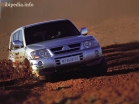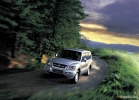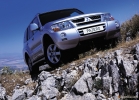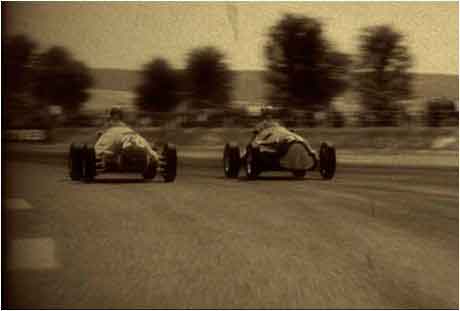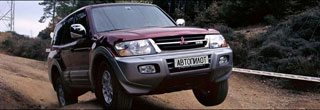Test drive Mitsubishi Pajero (Montero, Shogun) LWB 2000 - 2003 SUV
Checks without a road
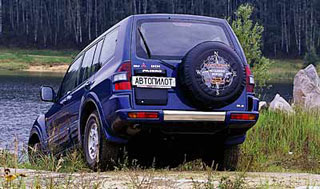 Once, the reader of the online version of the autopilot reacted to the test of the new SUV by a malicious offer to try it in his native Leningrad region on a regular highway. We took into account the wishes and drove the new Mitsubishi Pajero 3.5 GDI from the road.
Once, the reader of the online version of the autopilot reacted to the test of the new SUV by a malicious offer to try it in his native Leningrad region on a regular highway. We took into account the wishes and drove the new Mitsubishi Pajero 3.5 GDI from the road. The first acquaintance of the autopilot with the new generation of famous SUVs took place in March of this year. The report on this can be read in the April issue. Then, due to circumstances, it was not possible to fully understand the ability and capabilities of this machine. Which, in turn, gave rise to a lot of crank and snobberry-sketch assessments of experts, the essence of which was reduced to one thing: a jeep without a frame, without bridges, on an independent suspension-not a jeep! There were also those who immediately glued to him the wiped parquet label. In a word, many questions arose. So we decided to look for an answer to them in a real environment.
Preliminary race. On the asphalt, the new five -door Pajero is completely different from either its ancestor or most classmates and largely surpasses them. Both in terms of ergonomics and comfort, and smoothness, controllability and stability. In terms of reactions, it is much closer to a light car, which is achieved not only due to a reduced center of gravity and a progressive independent suspension with high energy intensity, but also by steering with a distinctly pronounced feedback.
The new character of the car has to get used to it for some time: the road is narrow and winding, replete with closed turns, descents and lifts, so at first you subconsciously strain, waiting for typical jeep validity, and are preparing to actively steal. And then you are surprised that nothing like that is happening. The third generation is much more stable, gently prescribing a given trajectory at speed, when any other traditional rear -wheel drive jeep would already be threateningly tilted and showed a clear readiness for skidding. Also much better begin to behave in quick restraint. It is very similar to a passenger car, however, it is worthwhile to get carried away a little speed when rebuilding, as a familiar transverse build -up of the body immediately occurs. Do not forget, they say.
This achievement is indisputable. But the main subject of pride Mitsubishi Motors is hidden under the hood. A new generation GDI’s direct injection, in which the combustion process controls by changing the time and volume of its supply directly to the combustion chamber, bypassing the intake manifold. Without going into details, let's say that the new technology made it possible to achieve stable engine operation in super -ind mixtures, due to which low -speed consumption and idling sharply decreased. Another important advantage of this motor is to achieve at low, about 1,500, torque revolutions of about 270 nm at a maximum moment of 318 nm at 4000 rpm. Hence the high painfulness and elasticity of the new motor.
Looking a little forward, we note that a 220-horsepower 3.5-liter engine showed more than a decent result in economy: the average consumption for two full days, according to the on-board computer, amounted to 15.2 liters per 100 km. And this despite the fact that the torn city regime and heavy off -road have made up much more than half of the run during this time.
Scylla and Haribda. Fans of an off -road driving from Montenegrin, Moscow Region, were looking forward to us. The first impression of the beginner made the most favorable. Then a somewhat depressed expression appeared on their faces. It turns out that they prepared us a route along which shortly before this was one of the stages of a 24-hour amateur off-road race, Alexander Brown Trophy. However, a flimsy-looking plastic body kit Pajero-III forced to significantly adjust intentions.
First, they maneuvered between the trees along the barely noticeable path in the editorial, fit into the narrow, just on the width of the car, and the corridor limited on all sides and stumps, which in some places was bent at almost 90 degrees. A small turning radius of 5.7 m, light steering, excellent visibility and a sense of dimensions allowed these small traps to drive on the first attempt.
Then there was a small, but malicious moat, about a meter deep, with steep clay slopes, on the sore bottom of which the text is a small stream. The 24-degree passport corner of the descent for the rear history was quite enough in reality, however, at the limit. Despite the completely not off -road rubber Dunlop Grandtrek and not the hardest soil under it, while bypassed 4H mode, without blocking the center differential. To push the joystick of the handout to the 4hlc position forced the further section of the path, where the deepest track alternating with the pits filled with liquid mixture of the earth and clay forced to lift the wheels of one side to the highest place. The wheels of the other side fell into a frank swamp, but Pajero walked, confidently moved forward, completely dispensed with lowered.
A real exam waited ahead-a huge pit with clumsy shores, with the deepest rut, half filled with some vile slurry. One could overcome it on the move, but this thought was rejected, since in this case the risk of gnawing decorative plastic was too great. The fluid, but relatively flat meadow left the real chance not to risk it. Here, of course, it took a reduced 4LC mode and forced blocking of the rear interventor differential. Fortunately, it was installed in our car. Pajero was placed, frankly, in a very tough framework. It was necessary, turning right at almost 90 degrees, literally wrapped around a hefty birch on the one hand and at the same time do not slip with the left side in that very deep hole. Skay into the clearing, immediately turn left and get out of it to climb. He succeeded. Almost. Because already at the exit of a quagmire, the road rubber wrapped over the oily layer of clay and surrendered ... in a completely decrease in the locks, all four wheels diligently rotated, the car did not finish completely, it lived and moved. However, we did not reject the hand of help in the form of a thick rope from the combat Range Rover of the Susanins. It turned out that our Pajero lacked the last smallness, a slight push. In general, he successfully coped with the task, only now we had to maneuver all the way between Scylla's desire to check it properly and the Haribda of fear of damaging a plastic mounted.
Memories of the future. But here is the insidious forest road behind, and we are opening in front of the pure blue lens of the lake in a frame of centuries -old pines. As if rejoicing that he nevertheless reached the goal and, without the very smallness, independently, with the sand dunes of the isthmus between the mainland and the island in the middle of the lake, our boy coped playfully. The 4LLC regime had to work only once, when it was necessary to climb a rather loose sand on a steep slide and overcome the ledge of the edge of a stone plateau upstairs.
The goal has been achieved. And with mud, and with steep descents and lifts, with fords and sand he copes. Now you can drown out the motor and summarize some results of the excursion.
The car turned out to be really new, interesting and unusual in all respects. He practically got rid of the characteristic jeep vices on the asphalt, and at the same time retained his essence as a remarkable SUV. The rogue, believe me, is one more. We encountered only two restrictions in this area: inappropriate rubber and plastic decorative kit. The first, however, is easy to replace, with the second more difficult.
Our past assumptions in terms of water and dirt and muddy ribs on the lower edge of the front bumper were only partially true. They, coupled with a powerful lower protection of the motor compartment, do not allow dirt to penetrate under the hood. What can not be said about the windshield, for all the dirt from the oncoming puddles flies on them unhindered.
The SS4-II transmission deserves the highest rating. Four modes, forced blocking of the center and rear inter -coil differentials, the automatic redistribution of the torque between the axes in the permanent all -wheel drive mode significantly expand the capabilities of the car. And the ease and ease of turning on the full -wheel drive of a new electronic distribution control system at speeds up to 100 km/h can actually literally save. In a situation where the car suddenly gets into a slippery area and begins to irresistibly carry it into the oncoming lane or to the ditch.
Objectively it turns out that in Pajero III, the off -road beginning did not weaken at all, so some contradictions are surprising. It is clear that the navigation system should compensate for the absence of a compass traditional for the previous generation, but for Russia it is not yet available. Compass, and the coonomer would not have prevented. As, however, a winch and a towbar, the installation of which is now very complicated by the design and design of the bumper.
The main emphasis in the development of the new Pajero was clearly placed on achieving maximum versatility. Hence many cars. However, if one of the owners wants to use it according to the full off -road program, the car will cope. You only need to prepare and stock up on additional equipment. And to solve for yourself a question with the notorious plastic.
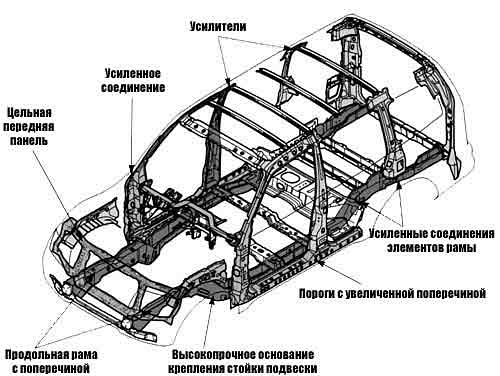
The first myth: only a staircase frame can provide an off -road car with the necessary rigidity for twisting and bending. Mitsubishi engineers found an original and optimal output, the essence of which boils down to one phrase - Pajero has a frame, but it is fundamentally different and integrated into the body. As a result, a decrease in the center of gravity by as much as 5 cm and a decrease in body mass. As for the stiffness of bending and twisting, the new Pajero body, according to the manufacturer, three times exceeds the previous frame structure in these parameters. There is no reason not to believe.
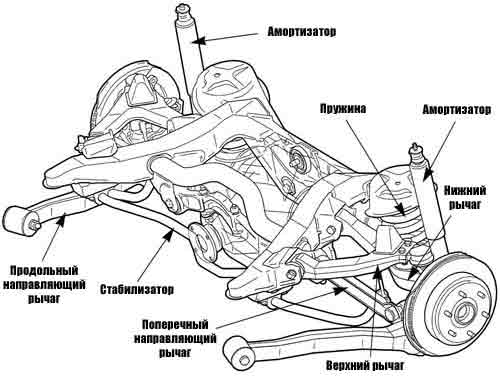
Myth two: for the jeep, the presence of hard bridges, at least one, rear. Not necessary at all. The completely independent Pajero III suspension proves this quite convincing. And in front and behind, it is mounted on powerful subframes. Firstly, the hardened mass has been significantly reduced; Secondly, the suspension course is increased from 240 to 270 mm, it has become more compact; Thirdly, the contact spot and the deviation from the vertical axis of the wheels are much smaller than on the hard bridge. The rear differential body, fixed on the subframe, raised on the ground, increasing the clearance to 235 mm against the previous 210. If you are not too lazy and look under the bottom, then fears regarding the vulnerability of the anthers and levers of independent suspension, if they do not disappear, will decrease. The levers of the pendants look powerful, and the same anthers are as if hidden inside the structure. All vital centers are protected, the bottom below is almost even.
Text Andrey Timofeev, photo Alexey Ilyin
A source: "Autopilot"
Mitsubishi Pajero (Montero, Shogun) LWB 2000 - 2003
Mitsubishi Pajero (Montero, Shogun) LWB 2000 - 2003
Mitsubishi Pajero Faults 5 doors: Detailed information| Pajero (Montero, Shogun) LWB 2000 - 2003 | |
|---|---|
| Engine |  |
| Transmission |  |
| Control system and suspension |  |
| Brake system |  |
| Air heating and air conditioning |  |
| Launch and charging system |  |
| Electric components and so on |  |
| Corrosion body stability |

